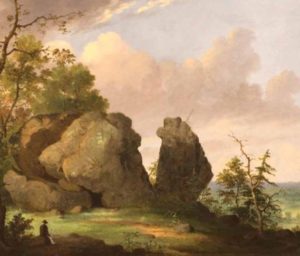
The Three Judges
Everyone who has lived in the New Haven area has eventually heard of the Three Judges who hid on West Rock. But who were they? And what were they hiding from?
In 1639, England’s King Charles I had a major falling out with his Parliament, who objected to his methods in the raising of funds for the military. Angered, he then ordered Parliament to adjourn but they refused; this was the beginning of civil war in England. In this civil war, a rebel army led by Oliver Cromwell, a Puritan leader in Parliament, was victorious. Subsequently, Parliament, under the direction of Cromwell, tried the king for treason, convicted him and beheaded him.
Cromwell then established a military dictatorship, which existed until his death in 1658. During this period, Puritanism became the state-supported religion, and Puritans returned in droves from New England to England.
After Cromwell’s death in 1658, Parliament re-asserted its loyalty to the Crown and invited King Charles’s son to become King Charles II. This restoration of the monarchy ended the revolution and began the counter-revolutionary phase.
Of the roughly 67 Regicides (also known as king-killers or judges–they were members of Parliament in 1639), 41 of these remained alive at the end of the revolution. Of this number, 29 were hunted down, captured, and tried, and 13 of them were executed as Regicides.
Our story is not of these, but it is instead of three Regicides who escaped the king’s men and traveled to New England; all were members of Parliament, and all were colonels in the English military. William Goffe and his father-in-law Edward Whalley arrived in the New Haven Colony in 1661; John Dixwell arrived here in 1664. The Puritan colonists were of course sympathetic, and hid and fed them. During two periods, the Regicides spent as much as a month at a time hiding in Judges Cave, a natural rock formation upon West Rock. One night, as it is told, they were chased from the cave by a mountain lion.
Eventually, representatives of King Charles II who had searched extensively for them, stopped coming around. John Dixwell had settled in New Haven and raised a family under an assumed name; he finally admitted to his real name upon his deathbed. Today, he is buried behind Center Church on New Haven Green. The other two judges had moved on and continued to hide elsewhere.
Today, to commemorate the Regicides and this chapter in New Haven history, three streets fan out north and west from Broadway in New Haven; they are Whalley and Dixwell avenues, and Goffe Street.
Judges Cave can no longer be accessed by automobile, as the auto road up West Rock was closed some 30 years ago; however, it is still reached by hikers on a popular path known as—you guessed it—the Regicides Trail.